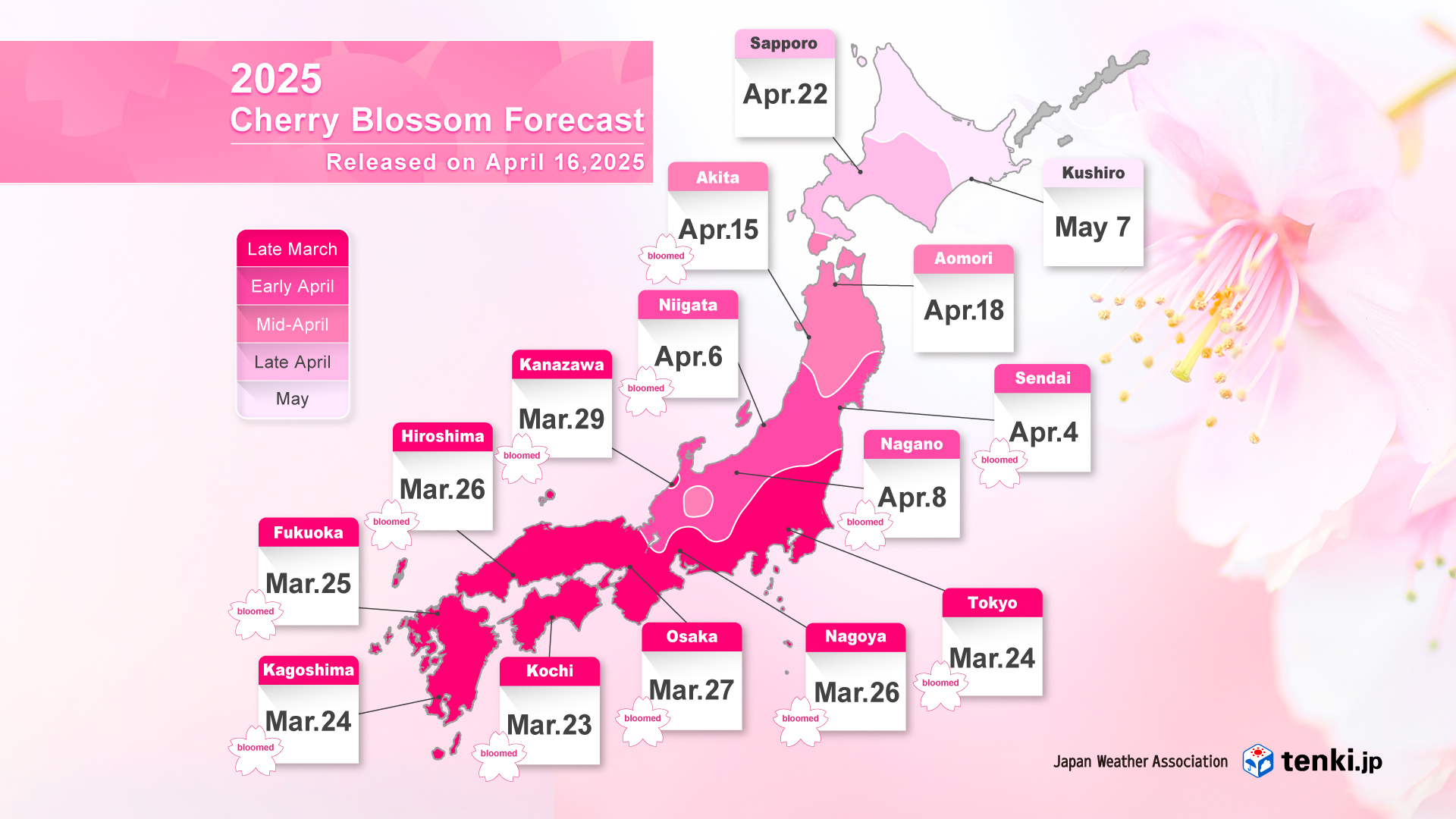- Home
- News
- Cherry Blossom and Full Bloom Forecast for 2025 (Part 7)
The cherry blossom front is moving northwards through the Tohoku region, and cherry blossom season is to begin in Hokkaido soon
News
Cherry Blossom and Full Bloom Forecast for 2025 (Part 7)
The cherry blossom front is moving northwards through the Tohoku region, and cherry blossom season is to begin in Hokkaido soon
2025.04.18
Press Release
Japan Weather Association (JWA) released its part 7 forecast for cherry blossoms and full bloom across 84 locations throughout Japan on Wednesday, April 16th, 2025.
◆Key points for the 2025 cherry blossom forecast (7th edition)
– Areas such as Hokuriku, Nagano, southern Tohoku and adjacent areas are now in Full Bloom.
– Northern Tohoku and Hokkaido are expected to bloom earlier than average overall.
– Full bloom is expected to occur in northern Tohoku towards the end of April, and in Hokkaido from late April to mid-May.
This is the last cherry blossom forecast of 2025.
In case of any extraordinary developments or updates to the forecast between 17th and 22nd of April, an updated forecast will be published on JWA’s weather forecasting media 【tenki.jp】, on their cherry blossom forecasting page.
For the most recent updates and information on the 2025 cherry blossom please visit the 【tenki.jp】 The Cherry Blossom and Full Bloom Forecast page: https://tenki.jp/sakura/expectation/ (Japanese only)
Cherry Blossom Forecast Map

2025 Blossoming Trend
As the cherry blossom front moves northwards, currently through the Tohoku region, many areas in northern Tohoku and Hokkaido are expected to bloom earlier than average, with some parts of Hokkaido expected to bloom significantly earlier this year.
Northern Japan experienced temperatures higher than average from March and beginning of April, and the warm weather is expected to continue throughout April. Because of these high temperatures, cherry blossoms are expected to pop up one after another across northern Tohoku by the end of this week. In Hokkaido, blossoms are expected to bloom 5 to 9 days earlier than average, between mid-April and early May.
2025 Full Bloom Trend
Higher altitude areas in Gifu and northern Tohoku are expected to reach Full Bloom around or earlier than the seasonal average, meanwhile many areas in Hokkaido are forecasted to reach full bloom significantly earlier than usual.
The peak viewing season has already passed in many areas from Kyushu to southern Kanto. Currently, regions such as Hokuriku, Nagano and southern Tohoku are experiencing optimal cherry blossom viewings. Looking ahead, northern Tohoku is expected to reach Full Bloom towards the end of April.
In Hokkaido, cities like Hakodate, Sapporo and Obihiro are expected to be in Full Bloom by the end of April, while other locations are expected to reach Full Bloom from early to mid-May.
Cherry Blossom Forecast Information
For more detailed information about JWA’s Cherry Blossom Forecast, please visit the link below.
https://www.jwa.or.jp/english/services-solutions/seasonal-news-cherry-blossom-forecast/
Cherry Blossom Season in Japan
For more detailed information on the cherry blossom forecast vocabulary and development, please visit the link below.
https://tenki.jp/sakura/english/160.html
[Description of words]
Normal: Average of 1991-2020
Much earlier: 7 or more days earlier than normal
Earlier: 3 to 6 days earlier than normal
Near normal: 1 or 2 days earlier or later than normal
Later: 3 to 6 days later than normal
Much later: 7 or more days later than normal
References Material
Frequently asked questions regarding cherry blossom forecast
-
AThe criteria are the same as those used by Japan Meteorological Agency. The flowering period starts the first day when 5 to 6 or more flowers have started to bloom on the designated observation tree (i.e. sample trees), and the full bloom date is the first day when more than 80% of the buds have opened on the sample trees.
-
AWe announce forecasts for 84 locations nationwide. The forecast locations consist of 53 sample trees observed by each Local Meteorological Observatory and 31 locations where observation data are obtained from cooperating agencies such as municipalities/local governments and parks.
-
AWe use our proprietary forecasting model that focuses on the temperature trends from autumn onwards, which significantly influence the growth process of the cherry blossom buds. Our forecasts are based on accurate observation data from sample trees at the Local Meteorological Observatories and cooperating agencies, emphasizing meteorological principles. Japan Meteorological Association has been conducting cherry blossom forecasts since 2007, making this year the 19th year of our endeavour.
-
AThe following data are used.Temperature observation data from the previous autumn to the forecast dateTemperature forecast data from the forecast date to the blooming period (from Japan Weather Association’s point forecasts and long-term forecasts).The temperature from the previous autumn to spring significantly influences the cherry blossoming period. Cherry buds form during the previous summer and then enter dormancy. Exposure to a certain period of low temperatures during winter breaks this dormancy, and the buds grow and bloom with rising temperatures. It is believed that higher temperatures promote faster bud growth and earlier blooming.
PDF DOWNLOAD:Cherry Blossom and Full Bloom Forecast for 2025 (Part 7)
